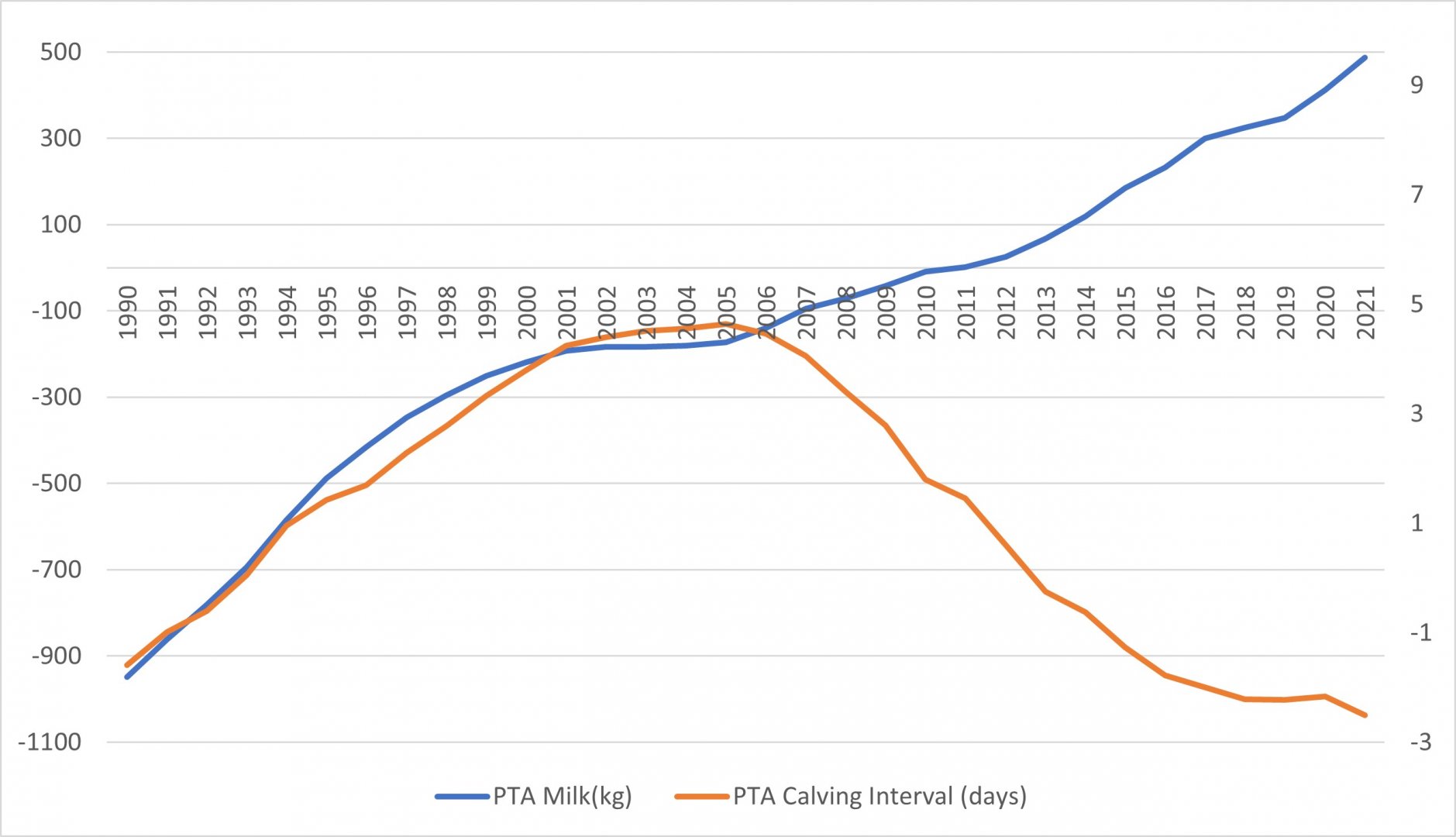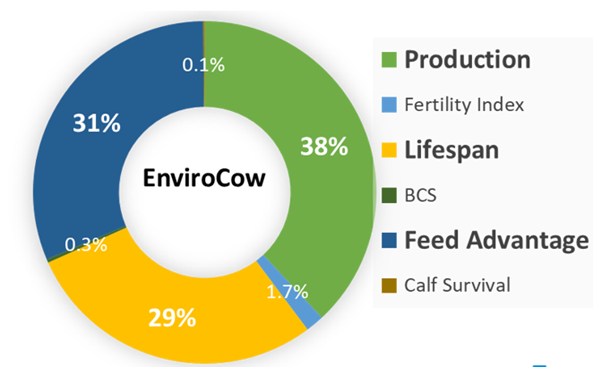
Better breeding can play a major role in achieving Net Zero, and new genetic indexes, introduced by AHDB in 2021, will help the process gather pace. By focussing on suitable traits in a breeding programme, it has been estimated that the dairy industry can reduce greenhouse gas (GHG) emissions by 20% over the next 20 years, simply by selecting better genetics. This is expected to be one of the most significant single contributors to the farming industry’s cut in emissions.
There are various factors behind this confident prediction, ranging from patterns of progress which have been made historically, to the UK’s independent research into feed efficiency. This is the most long running and extensive trial of its kind in the world and has led to the creation of one of the nation’s greatest dairy genetics research assets in the form of the largest known independent feed intake database.
Added to this is the fact that genetic changes are permanent and accumulate over the generations. This means a small, positive change made today can be multiplied exponentially across thousands of animals over the years ahead.
Historical context
But despite the promising outlook, dairy farmers have, in fact, been breeding to reduce GHGs since at least the 1990s, when genetic indexes to improve fertility, health and lifespan began to be introduced. This is because every step taken to improve the efficiency of dairy production is a step towards reducing emissions. Almost everything which has a financial implication, such as cutting waste and reducing culling, also has a beneficial environmental impact.
The impact genetics can have is demonstrated by many historical examples, not least in female fertility. This trait seriously declined between 1990 and 2005, when breeders made rapid progress in the genetics of milk production. But production and fertility are inversely related, such that producers were inadvertently selecting against fertility when they bred animals which gave more milk.
But when, in 2005, a female Fertility Index was introduced, the trend began to be reversed. Fertility Index was subsequently added to the UK’s national breeding index, Profitable Lifetime Index (£PLI), and the momentum gathered pace. Figure 1 shows how calving interval seriously declined between 1990 and 2005, at which point the genetic trend completely changed direction. This has led to ongoing improvements since 2005 and today, and we now see the genetics of fertility is marginally better than it was in the 1990s and continues to head in a favourable direction. Even more pleasing is the fact that this has occurred while the industry has continued to make significant improvement in the genetics of milk production.
Figure 1: Genetic merit of sires used in the UK, based on insemination data collected by NMR and CIS.

The power of genetics
All of this illustrates the power of genetics to help significantly and permanently address the dairy industry’s challenges. This will be enhanced as new genetic traits come on stream, giving an increasingly favourable outlook for the prospect of cutting carbon emissions.
All dairy cattle breeders need to do is decide upon their direction of travel and make breeding decisions to reflect these goals.
Economic breeding indexes – £PLI, £SCI and £ACI
The dairy industry has supported this endeavour by creating economic selection indexes designed to help producers identify the best bulls and make informed breeding choices.
The UK’s main breeding index, tailored for use in a typical, year round calving herd, is the Profitable Lifetime Index (£PLI). This is formulated for UK market conditions and will help producers – through improvements in a range of its component traits including production, efficiency, health and fertility – to breed more profitable cows.
The Spring Calving Index (£SCI) and Autumn Calving Index (£ACI) do likewise, with slightly different formulae to reflect the breeding needs of spring calving, grazing based and autumn calving, winter-housed herds, respectively.
However, all three of these economic selection indexes, broadly places one third of their emphasis on production and two-thirds on health, fertility, lifespan and efficiency. For this reason above all, they have always ultimately improved the efficiency of milk production which has a knock-on effect on GHG emissions.
New environmental genetic indexes
Today, AHDB has pushed this direction of travel further by formulating some new genetic indexes specifically designed to improve the environmental efficiency of milk production. It has done this in consultation with the Genetics Advisory Forum, an industry body which includes farmers and processors with breed society, milk recording, RSPCA, AI company and veterinary representation. These participants collectively review the genetic progress dairy breeds are making, the long-term market outlook for inputs and output, and they fine-tune the UK’s economic indexes as the need arises.
Working with AHDB’s service partners, EGENES at SRUC (Scotland’s Rural College), they introduced a HealthyCow index in 2021. Through this genetic index, producers can easily identify dairy bulls which will transmit the best overall health to their daughters.
While HealthyCow takes a step towards greater sustainability, this was even more specifically targeted when EnviroCow was launched later that year. This composite genetic index incorporates cow lifespan, milk production, fertility and, most importantly, the brand-new Feed Advantage index. This reflects the fact that the most feed-efficient animals also produce the least methane and makes EnviroCow the first independent genetic index in the world to focus solely on breeding cows for their environmental credentials.
Feed Advantage
The Feed Advantage component of EnviroCow predicts how much feed can be saved while maintaining a cow’s milk production. Its calculation is based on around 30 years of feed intake data collected from two lines of cows in the Langhill herd, based at SRUC’s Dairy Research and Innovation Centre.
Over this period, feed intakes have been measured from over 5,000 lactations and 2,000 Holstein cows throughout their entire lifetimes. This has created over 750,000 individual dry matter intake records.
Using this information, genotypes have been analysed and genomic predictions calculated such that it is now possible to predict feed intakes for all genomically tested Holsteins. These predictions have been demonstrated to work across the diverse range of genetic background and different feeding and production regimes across UK herds. And because feed intake has been found to be 18% heritable, there is scope to improve it through breeding.
Feed intake information goes on to be used in the calculation of the Feed Advantage, which adds a further dimension to the intake data. By comparing actual feed intake with theoretical feed intake based on the amount of milk solids the cow is giving and the feed she needs for her own maintenance, the Feed Advantage identifies animals which are the most efficient converters. These are the cows which turn a lower intake of feed into more milk solids in the context of the size of the animal itself. Body size itself is another important factor contributing to additional feed intake and so Maintenance index remains an important part of Feed Advantage and reflects the fact that an animal which is efficient at 800kg liveweight is not as efficient as an efficient animal requiring less feed for maintenance and whose weight is lower, at, say, 600kg.
This is important in the context of the average size of animal in the national dairy herd which is now genetically 30kg larger than in the 1990s. Across the national population, this means we already have to feed 60,000 tonnes of additional cow liveweight, just to maintain their additional body weight. This represents around 90,000 mature Holstein cows, or – in a herd of 200 – equates to 10 extra cows to feed each day.
The difference between the progeny of the most and least efficient Feed Advantage bulls is not insignificant, and the feed saving for one animal can be as much as 500kg of dry matter per lactation.
By including Feed Advantage within the calculation of EnviroCow, using this index will cut carbon footprint. Methane is by far the most significant contributor to dairy cow emissions, and its production in the rumen is strongly linked to dry matter intake. However, the index is concerned with intensity rather than gross output – in other words, how much methane is produced to create a kilogram of product, and that includes cull cow value as well as milk solids.
Figure 2 shows a breakdown of the EnviroCow index, indicating how the traits which contribute to an animal’s environmental credentials are included in its formula.
Figure 2: Relative contribution of traits to the EnviroCow index.

EnviroCow is published for both bulls and cows, with a higher figure reflecting better environmental credentials. All milk recorded producers can gain access to their own herd’s EnviroCow indexes which are available, free of charge, through AHDB in the Herd Genetic Report.
They will also note the strong correlation between £PLI and EnviroCow, confirming that animals which excel financially also tend to have better environmental credentials.
However, if breeders choose to target EnviroCow as their priority index, it is predicted that they’ll have scope to reduce their herd’s GHG emissions by around 1% per year. This means that over 20 years they can reduce their herd’s emissions by 20% through breeding alone.
With an array of choices before them, producers are urged to take control of their futures and define their breeding goals, ensuring they’re not a passenger directed by the whims of their breeding company.